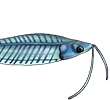Ancistrus sp. L-519
- mallemalle
- Posts: 242
- Joined: 03 Mar 2003, 18:53
- I've donated: $200.00!
- My images: 15
- My cats species list: 20 (i:1, k:11)
- My BLogs: 1 (i:1, p:29)
- Spotted: 29
- Location 1: Gjerdrum
- Location 2: Norway
- Interests: doradids,banjos,bumblebees and suckers.
Ancistrus sp. L-519
I'm picking up a group of these tomorrow. Anyone have any experience with this beauty?
Soup is good food!
- Jools
- Expert
- Posts: 16138
- Joined: 30 Dec 2002, 15:25
- My articles: 198
- My images: 948
- My catfish: 237
- My cats species list: 87 (i:237, k:1)
- My BLogs: 7 (i:10, p:202)
- My Wishlist: 23
- Spotted: 450
- Location 1: Middle Earth,
- Location 2: Scotland
- Interests: All things aquatic, Sci-Fi, photography and travel. Oh, and beer.
- Contact:
Re: Ancistrus sp. L-519
They are nice. I think @Acanthicus know about them but I am guessing, these are captive bred?
Jools
Jools
Owner, AquaticRepublic.com, PlanetCatfish.com & ZebraPleco.com. Please consider donating towards this site's running costs.
- mallemalle
- Posts: 242
- Joined: 03 Mar 2003, 18:53
- I've donated: $200.00!
- My images: 15
- My cats species list: 20 (i:1, k:11)
- My BLogs: 1 (i:1, p:29)
- Spotted: 29
- Location 1: Gjerdrum
- Location 2: Norway
- Interests: doradids,banjos,bumblebees and suckers.
Re: Ancistrus sp. L-519
I'm gettin'em from a shop that is shutting down, so i don't know to much yet. But i just came home from two talks tonight, were i learned a few more things about them. Most likely captive bred.
Soup is good food!
-
Tony4143
- Posts: 237
- Joined: 22 Sep 2015, 03:58
- My cats species list: 81 (i:0, k:25)
- My BLogs: 3 (i:0, p:27)
- My Wishlist: 34
- Spotted: 44
- Location 1: Tampa, Florida
- Location 2: USA
- Interests: Church, Family, Plecos, Corys, and fast cars
Re: Ancistrus sp. L-519
I have a group of 8 of them. All small but I have been feeding the usual foods green beans, squash, zucchini, etc.
- Acanthicus
- Posts: 862
- Joined: 24 Jan 2011, 14:32
- My articles: 5
- My images: 91
- My cats species list: 29 (i:0, k:0)
- Spotted: 79
- Location 1: Kiel
- Location 2: Germany
- Contact:
Re: Ancistrus sp. L-519
Hi,
they are definitely captive bred. All the thousands and thousands of L 519 are going back to a good dozen of specimens that were once brought back from South America. They are comparable in their demands with most of the longer known species of Ancistrus and easy to breed. Meanwhile many breeders have already had white and yellow offspring, turning back to normal colouration after a while. However it is only a matter of time until we we will see the first "breeding lines" I fear.
they are definitely captive bred. All the thousands and thousands of L 519 are going back to a good dozen of specimens that were once brought back from South America. They are comparable in their demands with most of the longer known species of Ancistrus and easy to breed. Meanwhile many breeders have already had white and yellow offspring, turning back to normal colouration after a while. However it is only a matter of time until we we will see the first "breeding lines" I fear.
Daniel
- Jools
- Expert
- Posts: 16138
- Joined: 30 Dec 2002, 15:25
- My articles: 198
- My images: 948
- My catfish: 237
- My cats species list: 87 (i:237, k:1)
- My BLogs: 7 (i:10, p:202)
- My Wishlist: 23
- Spotted: 450
- Location 1: Middle Earth,
- Location 2: Scotland
- Interests: All things aquatic, Sci-Fi, photography and travel. Oh, and beer.
- Contact:
Re: Ancistrus sp. L-519
I've updated the breeding info. on this species to reflect that info too.
Cheers,
Jools
Cheers,
Jools
Owner, AquaticRepublic.com, PlanetCatfish.com & ZebraPleco.com. Please consider donating towards this site's running costs.
- mallemalle
- Posts: 242
- Joined: 03 Mar 2003, 18:53
- I've donated: $200.00!
- My images: 15
- My cats species list: 20 (i:1, k:11)
- My BLogs: 1 (i:1, p:29)
- Spotted: 29
- Location 1: Gjerdrum
- Location 2: Norway
- Interests: doradids,banjos,bumblebees and suckers.
Re: Ancistrus sp. L-519
ThanksAcanthicus wrote: ↑08 Mar 2023, 19:17 Hi,
they are definitely captive bred. All the thousands and thousands of L 519 are going back to a good dozen of specimens that were once brought back from South America. They are comparable in their demands with most of the longer known species of Ancistrus and easy to breed. Meanwhile many breeders have already had white and yellow offspring, turning back to normal colouration after a while. However it is only a matter of time until we we will see the first "breeding lines" I fear.
Soup is good food!




